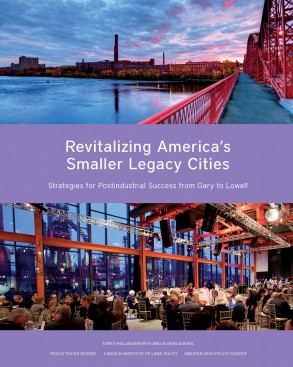This Policy Focus Report from the Lincoln Institute of Land Policy is titled Revitalizing America’s Smaller Legacy Cities: Strategies for Postindustrial Success from Gary to Lowell. It was written by Torey Hollingsworth of the Greater Ohio Policy Center, and their Executive Director, Alison Goebel. It was published in August of 2017.
It examines the unique challenges of smaller American legacy cities — older industrial centers with populations of less than 200,000, located primarily in the Midwest and Northeast. These cities are critical sites for a number of global economic and demographic transformations, and they must fundamentally reconsider how to rebuild and sustain strong economies, housing markets, and workforces.
The report identifies replicable strategies that have helped smaller legacy cities weather these transformations, find their competitive edge, and transform into thriving, sustainable communities.
One sample from the report’s insights is their praise for the revitalization efforts in Lancaster, Pennsylvania. They particularly liked the level of cooperation between its public and private sectors, and consider Lancaster a model for other small cities that need to reinvent themselves. “There’s a lot to learn from what Lancaster has done,” says Hollingsworth, who is the manager of research and policy at the Greater Ohio Policy Center.
The report identifies eight “strategies”:
- Strategy 1: Build Civic Capacity and Talent;
- Strategy 2: Encourage a Shared Public- and Private-Sector Vision;
- Strategy 3: Expand Opportunities for Low-Income Workers;
- Strategy 4: Build on an Authentic Sense of Place;
- Strategy 5: Focus Regional Efforts on Rebuilding a Strong Downtown;
- Strategy 6: Engage in Community and Strategic Planning;
- Strategy 7: Stabilize Distressed Neighborhoods;
- Strategy 8: Strategically Leverage State Policies.
I put “strategies” in quotes above, because those of you who are professional strategists—or who have read this Resilience Success Guide—will recognize that some of those listed could more-rightly be classified as revitalization tactics, good practices, or simply goals, rather than strategies. But nomenclature aside, there are many useful insights in this report, and it’s well worth reading.


